How to install the dishwasher yourself
Dishwashers are installed in the kitchen, near the sink. This is no accident. In this case, connecting the dishwasher is the simplest - the sewerage and water supply are nearby, and a separate socket for a stationary connection must still be installed.
The peculiarity of installing a dishwasher is that it must be set perfectly even. The maximum permissible deviation from the horizontal is 2 °. If this requirement is not met, the dishes may not be washed well enough. Therefore, the first step after unpacking is to install it in place and level it. For this, the design provides for height-adjustable legs. We take the building level, put it on the car, make sure that it stands exactly relative to the horizontal. Then we check the verticals, if everything was done correctly, and there should be no deviations.
The content of the article
Power requirements
Dishwashers, even economical ones, consume a lot of electricity. For example:
- for BOSCH SPS 40E12 (class A), maximum power consumption 2.4 kW;
- CANDY CDCF 6 07 (class A) consumption 1.3 kW.
- SIEMENS SR24E205 (class A) requires 2.4 kW to the maximum;
- ELECTROLUX ESF 9420 LOW - can consume 2.1 kW.
- WHIRLPOOL ADP 7570 IX - power consumption 2.1 kW.
With high power consumption, one of the conditions for normal operation is a separate power line with an installed circuit breaker and RCD. A separate line will also reduce the impact of power surges on the electronics that control the unit. They are felt whenever the refrigerator, freezer or microwave oven is turned on / off. The control board reacts very badly that all the jumps, and its replacement (almost no one repairs it, only changes it) costs a lot of money. If you want the equipment to work for a long time and without problems, pull a separate line from the shield.
As you understand, the average power of the dishwasher is 2.1-2.4 kW. First, we choose a circuit breaker. It must be selected by current, but the characteristics rarely contain this value, therefore you have to calculate the current by power. For example, the power of the dishwasher is 2.4 kW. We find the maximum current strength: 2400 W / 220 V = 10.9 A.
The circuit breakers are of the following ratings - 6 A, 10 A, 16 A, 20 A (there are also more powerful ones, but they are definitely not needed for this equipment). For this example, a 16 A machine is required.It is better not to take a 10 A machine - when turned on at full power, it will be knocked out. Therefore, we take the nearest higher value, and this is 16 A.
From the input of the circuit breaker, the phase is fed to the RCD. It protects against leakage during insulation breakdown, it will also work if someone touches live parts. It is also selected by current, but it must be one step higher than the machine. For this example, this is 25 A (RCDs are 10 A, 16 A, 25 A, 32 A). The second parameter by which this type of protection is chosen is the leakage current. For lines to which only one device is connected, the leakage current is 10 mA. Both of these devices are installed in house or apartment electrical panel.
Another parameter that needs to be determined is the cross-section of the cable cores. Copper wires have recently been used for wiring, since they are easier to work with. For devices with a power of up to 4.1 kW, a cross section of 1.5 sq. mm (more is possible, less is not).
Now about the sheath in which the cable should be. It depends on the material of the walls along which the power line will be laid:
- for wood and frame insulation should be double (VVG) or triple (NYM);
- in all the rest, any is suitable, without cracks, sagging and other visible damage.
Another point: dishwasher sockets must be grounded. This is a mandatory requirement for maintaining the warranty. Also, when choosing, pay attention to the voltage for which it is designed. For branded copies, this parameter is spelled out on the back. If there is no such inscription, you are in front of cheap Chinese consumer goods, and it is better not to risk it.
Where and how to withdraw the stock
The next step is to connect the dishwasher to the sewer. The drain hose is located on the rear wall of the housing, it has a length of about 1.5-2 meters. If necessary, it can be grown with a similar one of the same diameter, but the total length cannot be more than 5 meters (see exactly the instructions for use). Such a distance can be pumped by pumps that work when removing water.
The best option is to have a separate sewer outlet. Then everything is simple, a rubber sleeve is inserted into the branch pipe, providing a hermetic fixation of the corrugation, the end of the drain hose is filled into it. If it is covered with a plug, remove it. But this option is rather an exception. More often, the dishwasher is connected through a sink siphon or through an outlet to the sink.
If the sewer outlet is cast iron, there are special rubber couplings for a sealed transition to plastic. You will need to know the diameters of your outlet and plastic tee. Accordingly, the adapter is installed in the cast iron pipe. You just need to fill it up there without any additional funds. Insert a plastic fork into the sleeve. A sink is usually connected to a vertically directed outlet, and a dishwasher is connected to the one at an angle.
For special siphons for connecting a dishwasher, the outlet is made so that the drain hose can be pulled over it. For reliability, it can be tightened with a clamp.
The connection of the dishwasher to the sewer should be such as to avoid the formation of loops and creases, even when everything is pushed into place. At the same time, the corrugation should not be allowed to come up from the side - there should be a slight upward bend. This eliminates the possibility of drains from the siphon or tee entering the machine.
There are special plastic couplings for fixing the corrugated hose in a given position. They are put on the corrugation from below and hold it securely.
Water connection
The dishwasher is connected to the water supply using a standard hose, which is also located on the back of the case. It is easily recognizable by its rather large attachment. This is an overflow blocker. It is needed for correct operation and it is not recommended to delete it.
Now about which water to connect the dishwasher to. You can connect to a hot water only in one case - if your unit supports this function (indicated in the description) and you do not have a meter on the hot water supply. In all others, it is better to pour cold water into the machine. The main motive for connecting to hot water supply is to save electricity. If the water is hot, it does not need to be heated. This is true, but this solution has disadvantages:
- Hot water carries more contamination than cold water and your machine will break down faster.
- The d.h.w. temperature often exceeds the limits for the equipment. This again shortens the life of the equipment.
- If the DHW meter is installed, the savings are very small. The cons clearly outweigh it.
You can connect to the water supply at any point where there is a detachable connection. For example, in the place where the flexible hose is connected to the sink.Unscrew it, put a tee, then a ball valve (or a tee with a ball valve at once). On the part that connects the dishwasher with a tap, on the second outlet - a flexible hose to the sink mixer.
Checking before starting
Before pushing the machine into place, check the tightness of the connections. To do this, open the water supply (turn on the tap to which the dishwasher inlet hose is connected). If there is no leakage anywhere, you can slide it in.

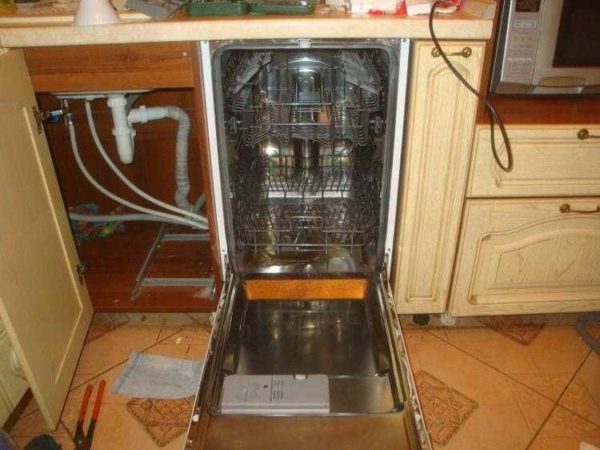
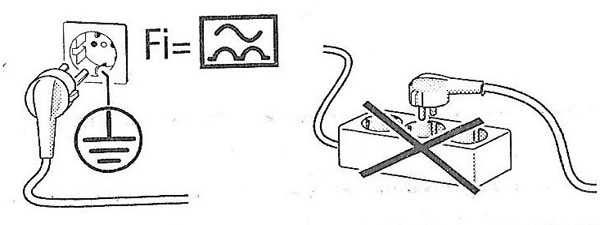
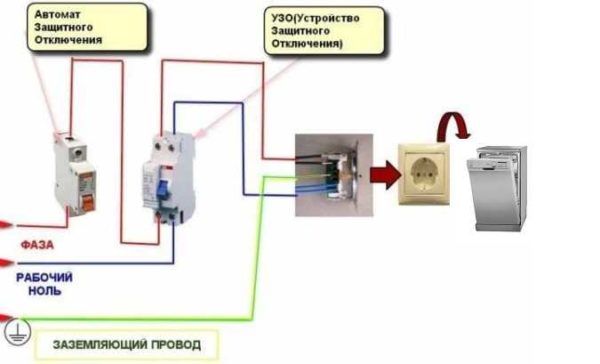
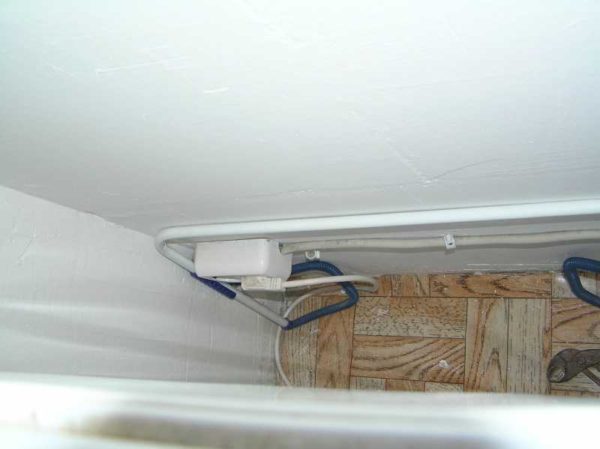
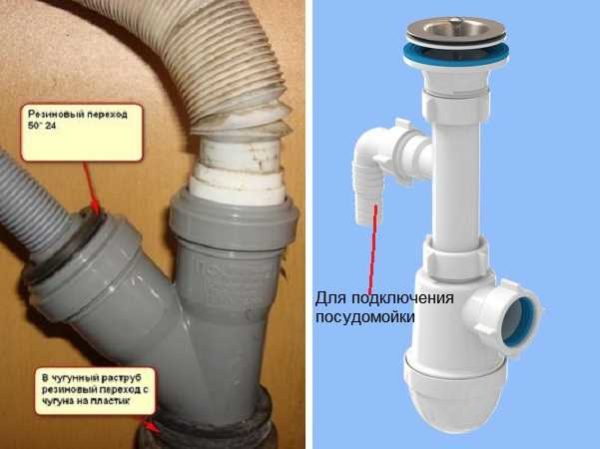
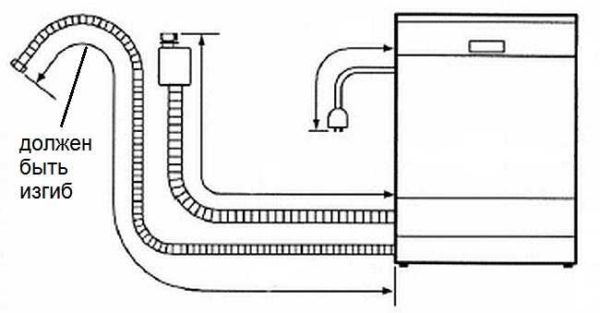
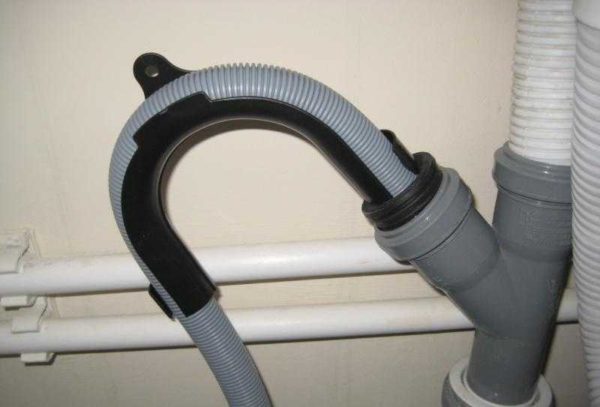
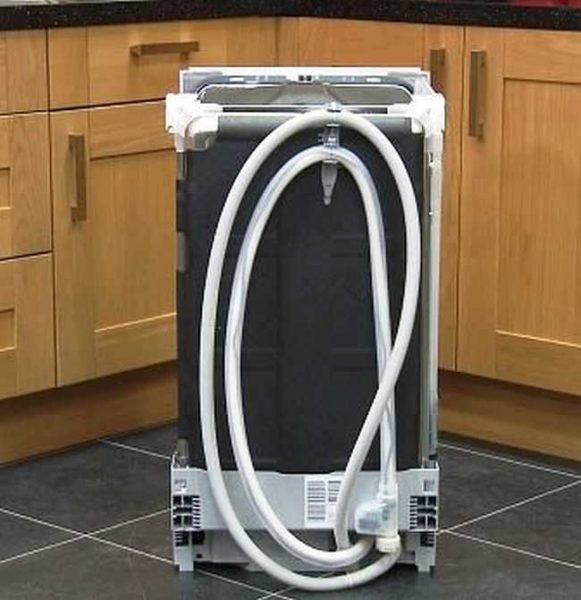

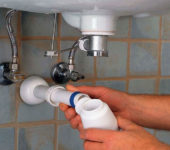
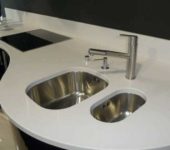


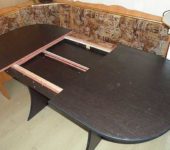





We bought a PMM machine with installation. The dishes are washed perfectly, even the crystal does not crack during gentle washing. I would not recommend connecting it yourself. Judging by the reviews, many people connected the machine incorrectly, and it either worked poorly for them, or the dishes were cold. For general development, you can read the article to control the installation process.
Natalia, do you have a drain hose attached to the dishwasher at the top? Or goes straight down the floor to the sewer?